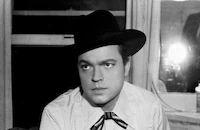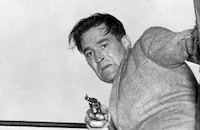South Seas Adventure
Cast & Crew
Orson Welles
Shepherd Mencken
Walter Coy
Ted De Corsia
Diane Beardmore
Marlene Lizzio
Film Details

Synopsis
Young Kay Johnson, a comptometer operator from Akron, Ohio has been saving a long time to take a luxury cruise to the island of Hawaii. Once there, she delights in the colorful native music and dance and meets Marlene Hunter and her brother Ted, members of an old and influential Hawaiian family. Ted takes Kay for a tour of the Hawaiian islands, showing her the naval base at Pearl Harbor on Oahu, Mount Haleakala volcano on Maui and the famed surf at Waikiki Beach. Meanwhile, several tourists board the schooner Te Vega for its journey westward to Tahiti. On board, artist Jean-Louis Martin anticipates discovering the land that influenced writer Joseph Conrad and painter Paul Gauguin. Upon arriving at Tahiti, Jean-Paul and the other tourists join the natives as they celebrate Bastille Day. Jean-Louis is attracted to the beautiful Turia from Bora-Bora, who wins an exciting dance contest. When the Te Vega resumes its journey through the South Pacific, Jean-Louis remains in Tahiti with Turia. Soon, the schooner arrives in Tonga, where the passengers are serenaded by a native choir. Sightseeing includes a visit to the shoreline to witness the activity of the famous blow holes. In Fiji the Te Vega is welcomed by Governor General Sir Ronald Garvey. When the travelers arrive in New Hebrides they are treated to an amazing courage-testing ritual that features young men diving head first from a platform one hundred feet high held only by vine cords around their ankles. The trip then resumes by air as travelers proceed to Australia. There, Stefan Koscheck and his family are introduced to the School of the Air, which allows residents in far flung outback communities to receive an education from teachers far away via two-way radios. The Koscheck family also receives a demonstration of a dependable system that allows a single doctor to visit patients miles apart by airplane. At the journey's final destination of New Zealand, former American G. I. Jim Perry introduces his wife to the untouched beauty of the country he discovered while recovering from injuries during the war. Upon returning to Hawaii, the travelers discover that Kay and Ted have decided to marry.

Cast

Orson Welles
Shepherd Mencken
Walter Coy

Ted De Corsia
Diane Beardmore
Marlene Lizzio
Commodore Harold Gillespie
Tommy Zahn
Igor Allan
Ed Olsen
Marcel
Walter Gibbons
Fred Bosch
Eddie Titiki
Ramine
Jay Ashworth
Maxine Stone
Don Middleton
Hans Farkash
Janice Dinnen
Eric Reiman
Sean Scully
Margaret Roberts
Mrs. Gibbs
Frank Basden
Dr. Huxtable
Vic
Crew
Joe Ansen
Jay Ashworth
Sabine Baring-gould
Marshall M. Borden
Fred Bosch
Jacob Y. Brodsky
Dan Cathcart
Carl Dudley
Carl Dudley
Carl Dudley
James Engle
Edward R. Evans
Daniel V. Finnerty
Walter Gibbons-fly
Richard Goldstone
Richard Goldstone
George Frideric Handel
Richard C. Harris
Paul G. Hill
Norman Karlin
Charles Kaufman
Karl Kayser
Warner E. Leighton
Avery Lockner
Norman Luboff
Lee Lukather
Francis D. Lyon
Hal Magargle
Harold Medford
Ray Morris
Alex North
Donald H. Nosseck
Leo W. Ross
Ray Sharples
Frederick Y. Smith
Walter S. Stern
Sir Arthur Sullivan
Eric Thompson
Walter Thompson
Alfred E. Wahrman
John F. Warren
Edward Warschilka
Ron Whelan
Basil Wrangell

Film Details

Quotes
Trivia
Notes
Although reviews and copyright records refer to the film as South Seas Adventure, the opening title card reads: Cinerama South Seas Adventure. South Seas Adventure was the fifth and final Stanley Warner-produced travelogue to use the Cinerama widescreen process. The other titles of the Stanely Warner-Cinerama travelogue productions were: This is Cinerama (1952), which visited various locations around the world; Cinerama Holiday (1955) which focused on sight-seeing in Switzerland, France and the United States; Seven Wonders of the World (1956) which explored natural and man-made wonders throughout the world, and Search for Paradise (1957), which toured Kashmir and Nepal. For more information on the Cinerama process, consult the entry for This is Cinerama (below).
Although South Seas Adventure was not viewed, according to the New York Times review, the film opened on board a Hawaiian-bound luxury ship. In Hawaii, the ponderous specialty camera was taken on surfboards to record the experience of surfing. The voyage then proceeded by schooner to Tonga, Fiji and New Hebrides and recorded various native ceremonies and celebrations. The highlight of the trip was the air flight to, and stops in, New Zealand and Australia, where numerous native traditions were explored before the return to Hawaii. According to the review, one particularly lively and humorous shot showed the Australian landscape "as seen from a kangaroo's pouch." Reviews also noted that Handel's The Messiah was sung in Tongan. The Hollywood Reporter review erroneously listed the film's running time as 108 minutes.
In a modern oral history at the AMPAS Library, co-producer-director Richard Goldstone provided the following information: Documentary producer Carl Dudley's extensive experience and familiarity with the South Pacific prompted his assignment to the project by Warner. Goldstone claimed creative development for the project and described an initial pre-production concept of following the 1787-1789 journey of the British ship The Bounty using actor Charles Laughton as narrator. Laughton portrayed The Bounty's Captain Bligh in the 1935 M-G-M feature film about the voyage, Mutiny on the Bounty (see AFI Catalog of Feature Films, 1931-40). Eventually with several writers working on the script, the production was divided into five separate stories that loosely followed the three South Pacific voyages by Capt. James Cook (in 1768-71, 1772-75 and 1776-80). During production, when the shooting unit was divided, it was decided that each segment would have a separate director. Dudley, who had suffered a heart attack during the film's pre-production stages, recovered to direct the Hawaiian segment that was photographed last, but placed first in the film's narrative. Goldstone described how the heavy camera was placed in a window in the nose of the plane to record the flight from New Hebrides to Australia. A small dark room was also built on the plane to allow film reloading while airborne. Goldstone noted that soundman Jay Ashworth starred as the main character in the New Zealand sequence. Goldstone's wife Chubby was featured in a small role as a nurse in the same sequence. Goldstone described the "kangaroo pouch" sequence as being shot with the Cinerama camera mounted on the bumper of a Land Rover with rigged tires that allowed a steady bouncing effect. Goldstone also pointed out that aside from some lines spoken by various indigenous participants, there were no speaking roles in the film.












